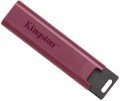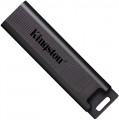Memory size
Total storage capacity. The larger it is, the more information can be simultaneously written to a USB flash drive. For comparison: the size of text documents rarely exceeds 1 MB, audio files and photos usually take several megabytes, short videos — several tens of megabytes, and a DVD-quality movie has a volume ranging from one and a half gigabytes and more. On the other hand, the price of the drive directly depends on this indicator. Thus, many manufacturers have flash drives similar in basic characteristics, differing only in volume — this makes it easier to choose the option that is optimal in terms of price and capacity.
Now on the market there are flash drives with the following volume:
4 GB,
8 GB,
16 GB,
32 GB,
64 GB,
128 GB,
256 GB,
512 GB and more.
USB version
The method of connecting a flash drive to a PC (laptop) provides both a connector (plug type) and an interface (speed). Among these are:
USB 2.0,
USB 3.2 gen1,
USB-C,
microUSB and
Lightning. More details about each of them:
—
USB 2.0. A universal interface used in computer technology to connect a wide variety of devices, including external drives. Version 2.0 provides data transfer rates up to 480 Mbps and is the most common today; almost all models of computers and laptops, and even some tablets, are equipped with such a port (often more than one). Note that the term "USB 2.0" in this case means an interface that uses a classic USB connector; models with a Type-C plug are listed in a separate category (see below).
—
USB 3.2 gen1. An improved version of the USB standard. It provides a 10-fold increase in data transfer speed (up to 4.8 Gbps) compared to the USB 2.0 revision, as well as higher power output, making it easier to connect multiple devices to a single port via a hub. As with USB 2.0 (see above), this category includes devices with the classic full-size USB connector. USB 2.0 and 3.2 Gen1 standards are mutually compatible — meaning that a USB 3.2 Gen1 port can easily connect to a second-generation device and vic
...e versa. The speed will naturally be limited by the slower interface, i.e., USB 2.0. At the same time, manufacturers may label their flash drives as 3.1 (the former name of the current 3.2 Gen2 interface), but the speeds indicate that this is not the second generation, but the first, i.e., 3.0 under the previous name. With the changing interface names, it can become even more confusing, so look directly at the speed indicators, which will more accurately describe the performance of the model.
— USB 3.2 gen2. The next major update to the USB interface after USB 3.2 Gen1 (previously also known as USB 3.1 Gen2 and USB 3.1). The maximum connection speed has doubled compared to the previous version — almost reaching 10 Gbps. As is typical for the standard, this interface uses a USB-A connector and is backward compatible with previous revisions — USB 2.0 and 3.2 Gen1. The only caveat is that the operating speed will be limited by the capabilities of the slower version.
— microUSB. A kind of "mobile" version of the USB standard, used in portable devices like smartphones and tablets. Accordingly, flash drives with such a connection interface are designed specifically for mobile gadgets, or rather, for equipment that supports the USB OTG function (see "Functions / Capabilities"). To connect via USB OTG peripherals with a regular USB plug, you would have to use an adapter, and a microUSB flash drive can be plugged in directly. At the same time, the design of such flash drives can also include a classic full-size plug, which makes them very versatile.
— USB-C. Formally, USB-C is not a separate connection interface, but a type of connector through which a connection can be made using one of the USB versions described above. The connector itself is significantly different from the classic USB connector. Firstly, it has a smaller size and can be used with equal ease in both stationary and portable equipment. Secondly, it is made double-sided, which greatly facilitates the connection: the plug can be inserted the first time even blindly, without worrying which side to turn the flash drive. This plug is not compatible with earlier USB ports, which is why USB-C flash drives are most often used in parallel with a regular full-size plug.
— Lightning. Also known as 8-pin. Apple's proprietary connector used in portable equipment (primarily iPhone and iPad), since 2012. Accordingly, the Lightning connector is equipped with flash drives designed for use with "apple" gadgets. Moreover, this interface, usually, is not the only one — it usually complements the standard USB connector.Features
—
Wi-Fi module. The presence in the design of the flash drive of a built-in module for wireless data transmission according to the Wi-Fi standard. This standard is widespread in modern electronics, its support is almost mandatory for portable devices such as smartphones, tablets and laptops. Initially, Wi-Fi was used to create computer networks, but more recently it has also been used for direct communication between devices, and the data transfer speed in modern versions is enough even for video streaming. The specific capabilities of flash drives with this feature may vary: some provide wireless communication only when connected to a computer (that is, they work like adapters), others are equipped with their own power sources and can function autonomously, playing the role of external storage with a wireless connection. Anyway, the presence of a Wi-Fi module may come in handy if you need to use a flash drive with the portable devices described above.
—
Built-in card reader. The presence in the design of the flash drive of a card reader — a device for reading memory cards. Thus, data can be written, stored and read using not only the drive's own memory, but also removable memory cards. Such cards are increasingly used as devices for storing information in modern mobile devices — mobile phones, players, etc.; a card reader greatly simplifies the exchange of information between such devices and a PC
.... Given the compact size of modern flash drives, such card readers are usually designed for microSD and similar formats.
— Hardware data encryption. The ability to encrypt data to write to the drive. Such flash drives have an additional chip responsible for encryption, and, unlike conventional password protection, information is written to the drive in an already encrypted form. This allows you to reliably protect confidential data — in case of loss or theft of the device, it will simply be impossible to read it.
— OTG support. Ability to use a flash drive in USB OTG mode. This technology is used in smartphones, tablets and other mobile devices; it allows you to connect various external peripherals to such equipment, including USB drives. The peculiarity of such a connection is that mobile gadgets usually do not have full-sized USB ports, and the connection is made via a regular universal connector — microUSB, USB Type-C or Lightning (see "Connection interfaces"). Actually, the presence of one of these connectors is mandatory for a flash drive with USB OTG support — due to this, you can use a drive without an adapter with a mobile device. Note that ordinary flash drives that have only a full-size USB connector can also work well with mobile equipment — however, an adapter is required for connection, so such models are not considered OTG-compatible.
— U3 Smart Drive support. U3 Smart Drive technology allows you to use a flash drive to store a complete set of user tools: programs, data, passwords, settings, etc. Thus, the user is freed from being tied to a specific computer and can change them at his discretion, each time continuing to work from the place where he left off last time — which is especially convenient if you often have to move between several computers or travel a lot. On the computer side, U3 Smart Drive technology is supported only by operating systems of the Windows family (starting from 2000 and higher).
— Fingerprint scanner. A device for recognizing the user's fingerprint. Allows you to restrict access to the contents of the flash drive: with properly configured settings, you can read information from the drive only after the scanner recognizes the correct fingerprint. This prevents unauthorized access to sensitive data.
— Write protection. The presence of a drive protection system against accidental overwriting — usually in the form of an external slider switch that blocks recording. Switching the flash drive to read-only mode allows you to protect important information on it from accidental erasure.
— Read/write indicator. An indicator (usually a light one) that indicates that data is being read from or written to a USB flash drive. During the exchange of information, the drive must not be disconnected from the computer — this is fraught with damage to both information and the device itself. The read / write indicator allows you to determine whether data is being exchanged and, accordingly, whether the USB flash drive can be turned off.Manufacturer's warranty
Manufacturer's warranty provided for this model.
In fact, this is the minimum service life promised by the manufacturer, subject to the rules of operation. Most often, the actual service life of the device is much longer than the guaranteed one. But an indicator of
5 years suggests that the flash drive is more likely to be lost or become irrelevant. You can also come across
a lifetime warranty, however, in this case it is better to drown out the details to which it applies. And anyway, it implies a certain period of time, though measured in decades. In addition to confirmation of reliability, such a guarantee allows you to contact the supplier after a while to eliminate possible problems (of course, not mechanical). But the difficulties in implementing this procedure (the representative office is located only in large cities) and the rare cases of the need for this (after all, it is easier to buy a new flash drive, with the exception of vital information on the old media) make the lifetime warranty more of a marketing ploy than a cool chip.

